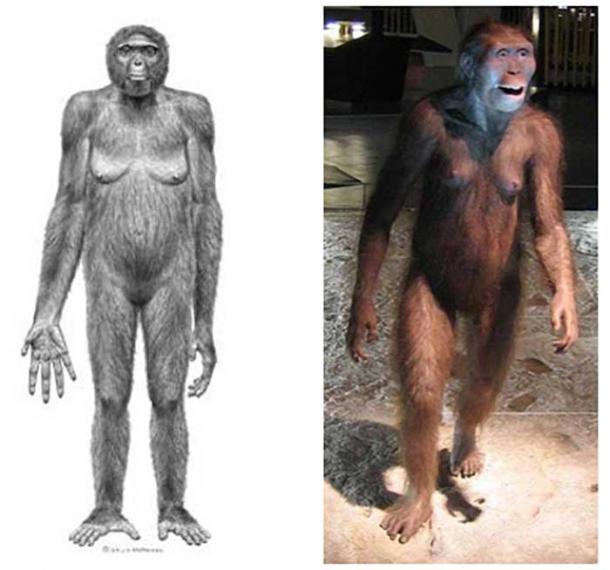Humans, chimpanzees, and gorillas all move similarly, and they share common anatomies. However, until now, it’s remained unknown how exactly humans were related to these other primates. That mystery of the “evolutionary leap” has now been solved, and the implications are Biblical.
Professor Thomas Cody Prang is a name you might hear more about very soon. He is an assistant professor of anthropology at Texas A&M University and he led the team of scientists who recently made the breakthrough in evolutionary sciences. The researchers analyzed a 4.4 million-year-old skeleton from an Ardi hominid ( Ardipithecus ramidus , Ardipithecus) that was discovered in Ethiopia, and their new observations were made in its “exceptionally well preserved hands.”

Ardipithecus ramidus, ‘Ardi.’ ( Fair Use ) Studying Ardi’s skeleton was key in discovering more about the evolutionary leap.
Well-Preserved Hands Holding Clues for an Evolutionary Leap
The so-called “Ardi’s” hands were compared with hundreds of others hand specimens from “recent humans, great apes, and dry-nosed primate.” The researchers looked at the types of locomotor behavior and hand restrictions experienced by the earliest hominins (fossilized human ancestors). The results of the study were published in Science Advances and show how early first humans began walking upright. Furthermore, it demonstrates how humans came to perform the range of movements we still use today.
Confirming Darwin’s Evolutionary “Theory” was a “Fact”
Study author Thomas Cody Prang says that among other things the study, as a whole, “confirms Darwin’s theory of the origin of man from apes.” This conclusion was reached after the scientists analyzed hundreds of bone samples and compare hand shapes, which reflect adaptations to primate habits and lifestyles. And with this new knowledge of how bone shape reflects behaviors, Dr. Prang says his team of researchers were able to draw inferences about the behavior of extinct species, such as the Ardipithecus.
Examination of the hand bones in this particular skeleton have given scientists deep insights into early hominin stone tool making and use. The aforementioned “large evolutionary leap,” however, was found when Dr. Prang compared Ardi’s hand with those of later hominins, including the species to which Lucy belonged ( Australopithecus).

Left: Scientific paleoartist Jay Matternes’ rendition of Ardi. ( Fair Use ) Right: A reconstruction of a female Australopithecus afarensis. ( Public Domain )
Looking at the evolutionary timeline this observed genetic “leap” occurred at what the researchers calls “a critical juncture when the hominins evolved to adapt to a more human form of upright walking.” According to the new paper the fact that Ardi represents an earlier phase in human evolutionary history, “is important because it potentially sheds light on the species of ancestors from which humans and chimpanzees descended.”

The evolution of hominin hands and feet reflects an evolutionary shift toward enhanced manipulative capabilities and obligate bipedalism, respectively. Partial hands, partial feet, and stone tool exemplars are depicted here and supplemented by reference to more fragmentary specimens preserving functionally relevant anatomies. Gray bars, facultative bipedalism; black bars, obligate bipedalism; red bar, approximate timing of hypothesized hominin evolutionary shift. (Prang, T.C. et al./ Science Advances 2021 )
Cementing Darwinism for Future Generations
What is perhaps the most impactful aspect of this new research project is that supports classic Darwinism. In 1871 Charles Darwin had little understanding of genetics, and less so about the use of hands in pre-history. He noted that upper limbs were used for manipulation and that they appeared in early human relatives in connection with upright walking in ancient humans. However, until now not everyone has been a fan of Darwin’s theory, and perhaps he has experienced no less fierce an enemy than the might of the Catholic Church.
According to a 2001 article in the Irish Times , the president of the Centre des Etudes et de Prospective sur la Science ( CEP), a 700-strong Catholic organization linked to scientists contesting evolution, said “Evidence does not support the theory of evolution.” They added that Darwin’s theory was “on the way out.”
These Catholic scientists maintained “No empirical proof exists that macro-evolution (that is, evolution from one distinct kind of organism into another) is occurring at present, or has ever happened in the past. No one, throughout recorded history, has ever seen it.” Furthermore, they argue that if evolution “had taken place” there should have been a great many transitional structures preserved in fossilized form recording the stages of development from one type of organism to another type.
Well. Guess what? That evidence has now been provided. Major changes in the anatomy of Ardi’s hands, and in the way all later hominins evolved, between approximately 4.4 and 3.3 million years ago, coincides with the earliest evidence for the loss of the grasping big toe in human evolution, according to the researchers. And if this is not the required hard evidence of evolution, then nothing will ‘work’.
Top Image: Scientists have found important evidence for an evolutionary leap between ancient hominids. Source: David Carillet / Adobe Stock
By Ashley Cowie
 RSS Feed
RSS Feed















 February 28th, 2021
February 28th, 2021  Awake Goy
Awake Goy  Posted in
Posted in  Tags:
Tags: 













